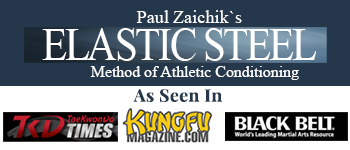Anatomy of the Twist Kick
Twist Kick, is called Bituro Chagi in Korean Martial Arts. It has lately been used by many non-Korean martial arts styles including various Kungfu, Karate and Mixed Styles.
Power and Effectiveness
The twist kick lands its effectiveness to surprise. It's attack comes from an unexpected direction from the opposite side of the round house. If performed as a stationary kick, it derives its power mainly from the extension of the knee and thus strength of the quadriceps.
Biomechanics
Biomechanics of the kick make the hip action a rather difficult accelerator. In other words the pelvic momentum is rather difficult to generate, in order to transfer it into the knee. It is possible, but more challenging than the roundhouse kick or front kick for example.
Using the full mass of the body, as opposed to just the pelvic whip, is a much more effective method of generating force. However that is a biomechanic model of the kick and we will leave it to the next article.
Kinesiology
Today's article focuses on the kinesiological model of the kick. In this article we will discuss the muscles that contact and lengthen to make the correct Twist Kick possible.
There are 3 phases to the kick. Phase one and phase three are similar.
Phase One - Chambering or Folding of the Kick
The kicking hip and knee flexes. There are some stylistic as well as individual variations in this face.
- Some styles and/or practitioners will lift the knee with a vertical shin. Others will already begin the turnout at the hip.
- Some will face the opponent squared, other will turn partially.
- The kicking foot may already expose the ball of the foot or instep, or the sticking point may form as the foot moves toward the target.

In general all the hip flexors will participate in lifting the knee straight up. Rectus Femoris will be negated by contraction of the Hamstrings to flex the knee.
If the hip will already turnout at the folding of the kick, muscle behavior will change:
Sartorius who favors the lateral rotation will take on a greater role. Muscles that favor the medial rotation, will take on a lesser role. Those are all Adductors, and Tensor Fascia Latae. They will still participate, but to a lesser degree.
- Two deep and powerful hip flexors: Psoas and Iliacus, favor the flexion of the hip and medial rotation, will contract full force.
Quadriceps Vastii (3 Short Heads of Quadriceps) will stretch in preparation for a kick, as they are the deliverer of the force. Gluteus Maximus, Ischial Fibers of Adductor Magnus and Piriformis will lengthen as well.
The Standing Leg
In the standing leg Quadriceps will contract to keep the partially flexed knee from collapsing. Calf will contract as the knee moves over the toes. The center of gravity will shift left, over the left foot. This will activate the gluteal group to check the adduction of the supporting leg. Gluteus Maximus will also work to stop further hip flexion.
- If the torso leans back, the hip flexor and anterior core muscles will fire.
- Unless the right hip flexors are very strong, chances are the posterior pelvic till will be initiated to lift the kicking leg higher.
Phase Two
Phase Two can be looked at as a demonstration of form or power and reach:
- From the form point of view, the knee extends.
- From the power and reach point of view the pelvis is shifted and torso leans away. This allows the kick to travel the furthest, both toward the target and into the target, as not to be pulled back too early.

The extension of the knee is carried out by the Quadriceps as mentioned earlier. While this is a strong muscle, its contracting force alone is not enough to generate significant damage. To do that, the quads must be a last link in a well executed force generating chain. If the kick is slowed down various hip flexors and adductor will work to hold the hip in the right position.
Sartorius will be negated partially by the extension of the knee, as it is a flexor of the knee. All Adductors will assist by "won't be happy" but lateral rotation.
In addition Gracilis will be partially negated by knee extension. Distal attachment or Sartorius and even Gracilis is particully vulnerable to injury, if the kick is not properly prepared. Due to the tendency to rotate out at knee and not at the hip, most kickers will rely heavily on insertions of these muscles and medial hamstrings to decelerate the kick. This happens because the just named muscles will not only prevent the knee hyper extension, but also hyper lateral rotation. Having flexible medial rotators of the hip and strong flexors/lateral rotators will protect from this type of injury. Later being the Psoas and Illiacus.
Supporting Leg
The muscles working on the supporting leg are virtually the same as for phase one. Of course core and Flexors and Adductors may engage more, with an attempt to either reach further with the kick or if the Hamstrings are not flexible enough and pelvis must tilt to compensate.
Finally the muscles lengthening on the kicking leg will still be the same with an addition of the Hamstrings. Later will be stretched due to extended knee.
- Tibialis Anterior will be stretched to plantar flex the ankle, if the point of impact is the instep.
- Flexor of the toes will lengthen if the ball of the foot is the point of impact.



Comments
Leave a comment